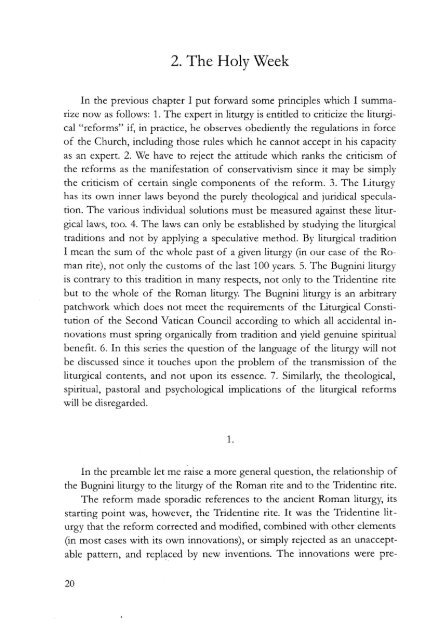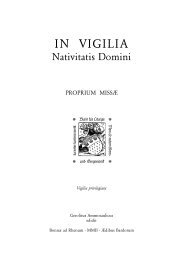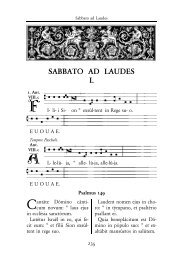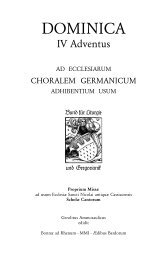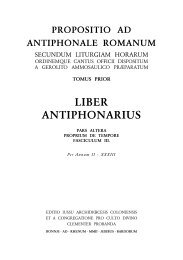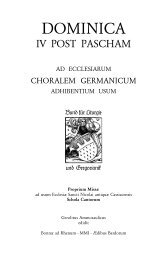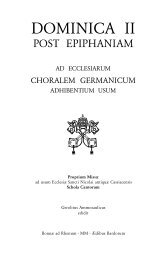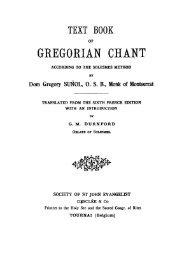The Bugnini-Liturgy and the Reform of the Reform - MusicaSacra
The Bugnini-Liturgy and the Reform of the Reform - MusicaSacra
The Bugnini-Liturgy and the Reform of the Reform - MusicaSacra
Create successful ePaper yourself
Turn your PDF publications into a flip-book with our unique Google optimized e-Paper software.
2. <strong>The</strong> Holy Week<br />
In <strong>the</strong> previous chapter I put forward some principles which I summarize<br />
now as follows: 1. <strong>The</strong> expert in liturgy is entitled to criticize <strong>the</strong> liturgical<br />
"reforms" if, in practice, he observes obediently <strong>the</strong> regulations in force<br />
<strong>of</strong> <strong>the</strong> Church, including those rules which he cannot accept in his capacity<br />
as an expert. 2. We have to reject <strong>the</strong> attitude which ranks <strong>the</strong> criticism <strong>of</strong><br />
<strong>the</strong> reforms as <strong>the</strong> manifestation <strong>of</strong> conservativism since it may be simply<br />
<strong>the</strong> criticism <strong>of</strong> certain single components <strong>of</strong> <strong>the</strong> reform. 3. <strong>The</strong> <strong>Liturgy</strong><br />
has its own inner laws beyond <strong>the</strong> purely <strong>the</strong>ological <strong>and</strong> juridical speculation.<br />
<strong>The</strong> various individual solutions must be measured against <strong>the</strong>se liturgical<br />
laws, too. 4. <strong>The</strong> laws can only be established by studying <strong>the</strong> liturgical<br />
traditions <strong>and</strong> not by applying a speculative method. By liturgical tradition<br />
I mean <strong>the</strong> sum <strong>of</strong> <strong>the</strong> whole past <strong>of</strong> a given liturgy (in our case <strong>of</strong> <strong>the</strong> Roman<br />
rite), not only <strong>the</strong> customs <strong>of</strong> <strong>the</strong> last 100 years. 5. <strong>The</strong> <strong>Bugnini</strong> liturgy<br />
is contrary to this tradition in many respects, not only to <strong>the</strong> Tridentine rite<br />
but to <strong>the</strong> whole <strong>of</strong> <strong>the</strong> Roman liturgy. <strong>The</strong> <strong>Bugnini</strong> liturgy is an arbitrary<br />
patchwork which does not meet <strong>the</strong> requirements <strong>of</strong> <strong>the</strong> Liturgical Constitution<br />
<strong>of</strong> <strong>the</strong> Second Vatican Council according to which all accidental innovations<br />
must spring organically from tradition <strong>and</strong> yield genuine spiritual<br />
benefit. 6. In this series <strong>the</strong> question <strong>of</strong> <strong>the</strong> language <strong>of</strong> <strong>the</strong> liturgy will not<br />
be discussed since it touches upon <strong>the</strong> problem <strong>of</strong> <strong>the</strong> transmission <strong>of</strong> <strong>the</strong><br />
liturgical contents, <strong>and</strong> not upon its essence. 7. Similarly, <strong>the</strong> <strong>the</strong>ological,<br />
spiritual, pastoral <strong>and</strong> psychological implications <strong>of</strong> <strong>the</strong> liturgical reforms<br />
will be disregarded.<br />
1.<br />
In <strong>the</strong> preamble let me raise a more general question, <strong>the</strong> relationship <strong>of</strong><br />
<strong>the</strong> <strong>Bugnini</strong> liturgy to <strong>the</strong> liturgy <strong>of</strong> <strong>the</strong> Roman rite <strong>and</strong> to <strong>the</strong> Tridentine rite.<br />
<strong>The</strong> reform made sporadic references to <strong>the</strong> ancient Roman liturgy, its<br />
starting point was, however, <strong>the</strong> Tridentine rite. It was <strong>the</strong> Tridentine liturgy<br />
that <strong>the</strong> reform corrected <strong>and</strong> modified, combined with o<strong>the</strong>r elements<br />
(in most cases with its own innovations), or simply rejected as an unacceptable<br />
pattern, <strong>and</strong> replaced by new inventions. <strong>The</strong> innovations were pre-<br />
20


